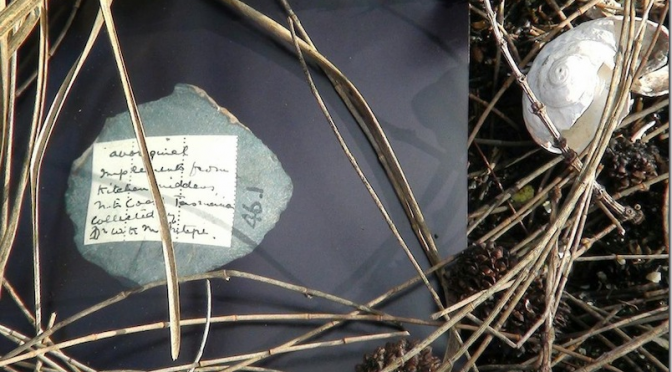
Julie Gough, The Lost World (part 2), 2013, installation detail. Photo courtesy the artist
28 June 3-5pm
Contemporary Art Tasmania, Hobart What does it mean to make art in the South? How does living at the end of the world condition what we see? The Hobart roundtable considered particularly the creative act of gleaning as a means of recovering what is otherwise left behind. This can apply to not only material detritus but also lost histories that have been overlooked in the march to progress and empire. The roundtable began with discussion about the relationship between Australia and Latin America. The
Buen Vivir movement in Bolivia and Ecuador was seen as an important model for a culture of responsibility towards the environment. More specifically, the regions of Tierra del Fuego and Tasmania were considered to have much in common. But counterbalancing the connection was a history of oppression and corruption in many countries of Latin America that belie its more idealist tendencies. In between the two continents, New Zealand offered an important model in the case of the Whanganui River, which in August 2013 gained recognition as a legal entity in itself. The river had originally been exempted from the Waitangi Treaty, but has since been subject to overuse, such as mining for gravel to build roads. But from a Māori perspective, the river is a living entity which cannot be subsumed only to human interests. This model could be relevant to other locations, such as the Great Barrier Reef. There are many issues that need to be considered in Australia. The relative rarity of second languages means it is harder to entertain multiple perspectives on the world. Within art schools, there is no allowance for the validity of knowledge systems apart from the PhD. In this context, art can play a role in opening up alternative possibilities. A number of works were mentioned:
- Tasmanian photographers Olegas Truchanas and Peter Dombrovskis created a bridge to nature
- Bea Maddock’s etching Terra Spiritus circumnavigates Tasmania replacing European names with local versions, using ochre pigments
- Julie Gough’s exhibition Lost World, Part 1 and Part 2
- Elizabeth Lada Gray compared Tasmania and Tierra del Fuego.
- Natasha Cica’s Think Tent sits ten people, with selected guest speakers that engage with public for an hour at a time.
- Justine Shoulder club based community artist, located in space between dance floor and garden. Animist creatures that possess him. Had big commission from Performance Space.
- The book Pride Against Prejudice by Ida West is an important contribution to reconciliation
- Local council road signs for Mount Wellington as kunanyi
South is an important identity for Tasmania. At the bottom of the world, it offers a space for alternative activities that slip below the radar, that might otherwise not be possible in the metropolis. On the other hand, however, it has become a marketing term with romantic associations useful for selling gourmet food and tourist experiences. It was said: ‘Underlying this is a murmur in the back of our minds about a paradise lost that can be regained.’ There is potential to engage with other Souths. Singapore, for instance, has a complex relationship to the North. In such centres, one can feel that one should replicate models located in the North in order to develop. This creates a counter argument for the importance of local referents. The roundtable revisited a proposal that Greg Lehman and Jim Everett developed as part of the South 1 event in 2004. The idea for the Museum of Southern Memory emerged originally as a response to the work of Marcelo Brodsky in Argentina, who documented the memories kept alive of those who were disappeared during the military dictatorship in the 1980s. There seemed an important role for an institution that could house those memories which need to be kept alive. It was said, ‘Tasmania is part of the geo-political South of Australia. One aspect is that after the colonial tsunami has washed over and retreated, it wipes away native cultures and people.’ The proposed museum would share Tasmania’s experience of loss and recovery with other parts of the South. It could be a museum towards which any visitor might feel they could make a contribution. As well as including stories of victims, there is potential to also include non-literate techniques for memorialisation, such as knotting. This was highly developed in the practice of quipu as a form of record keeping in Inca Peru. In general, the table agreed on the importance of maintaining multiple perspectives. The binary identity of indigenous and non-indigenous did not reflect the way in which we are all products of a colonial mindset and we all have a potential relation to place. The group will continue to work on the idea of a Museum of Southern Memory, eventually with input from other voices in the South. Present:
Julie Gough The Lost World (part 2), 2013 Museum of Archaeology and Anthropology, University of Cambridge, and CAT (Contemporary Art Tasmania) (Solo exhibition) Curated by Khadija von Zinnenburg Carroll Design by Christoph Balzar Technical design by Ronald Haynes and Mark Sheppard +23 October – +30 November 2013 Project URL: CAT (Contemporary Art Tasmania), http://www.contemporaryarttasmania.org/program/the-lost-world-part-2 Project URL: Museum of Archaeology and Anthropology, University of Cambridge http://maa.cam.ac.uk/maa/the-lost-world-part-2/

